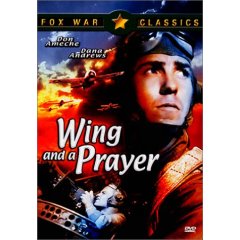- Wing and a Prayer
Infobox Film | name =Wing and a Prayer

caption =Wing and a Prayer DVD
director =Henry Hathaway
producer =William Bacher
writer =Jerome Cady
starring =Don Ameche Dana Andrews William Eythe
music =
cinematography =
editing =
distributor =Twentieth Century Fox Film Corporation
released =December 21 , 1949 (Los Angeles, California) (premiere)
runtime = 92 min
language = English
budget =
imdb_id = 0037466"Wing and a Prayer" (also known as "The Story of Carrier X") is a black-and-white 1944
war film about the heroic crew of an American carrier in the desperate early days ofWorld War II in the Pacific theater. Although arguably a classic propaganda movie, it was appreciated for its very realistic portrayal and was nominated for the 1944Academy Award for Best Original Screenplay .Plot
In the days just after the
attack on Pearl Harbor , the American people are asking ‘What is our fleet doing?’ Gravely weakened by the disaster, the Navy comes up with a plan to trap the Japanese fleet. Flight commander Bingo Harper (Don Ameche) is in charge of the bomber crews on one of the aircraft carriers that, in fact, shouldered the burden in the desperate early days of the war. He is tough and sticks to the rules, while his young pilots behave more like youngsters and do not always follow his logic.A new squadron led by Lieutenant Commander Edward Moulton (Dana Andrews) is assigned to the carrier. From the very first landing, Harper notices a careless attitude by ex-Hollywood Academy Award winning star Ensign ‘Oscar’ Scott (
William Eythe ). Harper warns Moulton that the squadron’s safety cannot be jeopardized and any repeat of the sloppiness will not be tolerated. Moulton does his best with his men, but he is far from having absolute control. During a bombing run, Ensign Breinard (Harry Morgan ) drops a bomb close to the carrier and Harper grounds him. When a young ensign fails to follow the correct takeoff procedure and ditches his plane into the sea, Harper forbids him to fly again.In the meantime, a message is received from Navy headquarters. The carrier is ordered to travel deep into enemy territory, near the
Solomon Islands , and make its presence known in order to deceive the Japanese about American fleet dispositions and intentions. However, they are under strict orders not to fight. When Moulton's bombers encounter some Japanese planes, they follow orders and retreat, but two planes are lost. Not knowing the plan, the pilots are furious. This is repeated several times in other widely-separated locations, driving the aviators to the brink of rebellion. However, the carrier accomplishes its mission: the Japanese believe that the sightings are of different American carriers, not just one.Finally, the long-prepared trap is sprung. Deceived into believing that the American carriers are scattered across the Pacific, the Japanese are taken by surprise when the American fleet attacks their carriers. Many pilots are lost, but the Americans win a great victory. However, the last bomber, flown by Scott and very low on fuel, has trouble finding the carrier hidden by low clouds. Moulton begs Harper to turn on the searchlights to guide him in, but Harper refuses to risk betraying the carrier's location to any Japanese submarines that may be lurking nearby. Eventually, Scott’s plane is heard crashing into the water when it runs out of fuel. Moulton and Harper quarrel, but in few minutes, it is reported that Scott has been picked up by a destroyer. Harper explains that he cares for all his pilots, but he is willing to sacrifice a few for the success of the mission.
Historical accuracy
The film loosely portrays actual historic events related mainly with the
Battle of the Coral Sea and theBattle of Midway . The scenario is, however, intentionally changed in order to justify the initial defensive rather than offensive posture of a US Navy reeling from the early Japanese victories in 1942. The Battle of the Coral Sea is justified as a calculated plot to deceive the Japanese, while the Battle of Midway is depicted as a trap where the enemy was caught at a disadvantage. In actuality, the losses at Pearl Harbor and the numerical superiority of the Japanese had the Americans operating constantly on the defensive in the early period of the Pacific war. It was mainly superior military intelligence that paved the way to the crushing American victory at Midway.It also exaggerates the attitude of the carrier commanders who would rather spend the lives of their aircrews rather than risk their carriers. On one occasion, a carrier skipper ordered the light beacons turned on to guide his returning crews back, accepting the risk of revealing his position.
The planes used were mainly Grumann
TBF Avenger torpedo bombers and, in a few scenes,Grumman F4F Wildcat s and DouglasSBD Dauntless es. The carrier is a typical Essex class, resembling the ones actually deployed. The action on the carrier deck is convincing as well as the characters of the pilots. Real footage is mixed with action shot on the carrier.Cast
*
Don Ameche "as" Flight Commander Bingo Harper
*Dana Andrews "as" Lieutenant Commander Edward Moulton
*William Eythe "as" Ensign Hallam 'Oscar' Scott
*Charles Bickford "as" Captain Waddell
*Cedric Hardwicke "as" the Admiral
*Kevin O'Shea "as" Ensign Charles 'Cookie' Cunningham
*Richard Jaeckel "as" Beezy Bessemer
*Harry Morgan (credited as Henry Morgan) "as" Ensign Malcolm Brainard
*Richard Crane "as" Ensign Gus Chisholm
*Glenn Langan "as" the Executive Officer
*Renny McEvoy "as" Ensign Cliff Hale
*Robert Bailey "as" Ensign Paducah Holloway
*Reed Hadley "as" Commander O'Donnell
*George Mathews "as" Dooley
*B.S. Pulley "as" Flat TopFilm Reviews
* [http://www.imdb.com/title/tt0037466/ Film information and review]
* [http://movies2.nytimes.com/gst/movies/movie.html?v_id=54783 Film overview & plot details]
Wikimedia Foundation. 2010.
